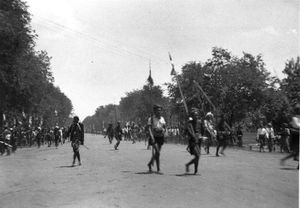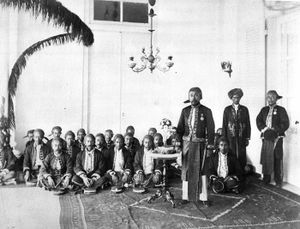Difference between revisions of "Calsean War"
m |
Pittman789 (talk | contribs) m |
||
| Line 6: | Line 6: | ||
| image_size = | | image_size = | ||
| alt = | | alt = | ||
| caption = Mujansan militiamen organize for drills | | caption = Mujansan militiamen organize for drills | ||
| date = | | date = June 9, 1891 - May 2, 1893 | ||
| place = Southern Nagu | | place = Southern Nagu | ||
| coordinates = <!--Use the {{coord}} template --> | | coordinates = <!--Use the {{coord}} template --> | ||
| Line 25: | Line 25: | ||
| combatant2 = [[File:Calsean Kingdom Flag.png|25px]] [[Calse|Calsean Kingdom]]<br>{{flag|Mujansa}} | | combatant2 = [[File:Calsean Kingdom Flag.png|25px]] [[Calse|Calsean Kingdom]]<br>{{flag|Mujansa}} | ||
| combatant3 = | | combatant3 = | ||
| commander1 = {{ | | commander1 = {{flagicon|Cananganam}} [[Bichri|Bichrī́]]<br>{{flagicon|Cananganam}} [[Saniya|Sanī́yā]]<br>{{flagicon|Cananganam}} [[Roocha|Rṓcā]]<br>{{flagicon|Cananganam}}[[Arhasa|Ārhā́sā]] | ||
| commander2 = [[File:Calsean Kingdom Flag.png|25px]] [[Luosafo|Luośāfo]]<br>[[File:Calsean Kingdom Flag.png|25px]] [[Pakantosa|Pākantosā]]<br>{{Flagicon|Mujansa}} [[Lysadem|Lȳ sá dem]]<br>{{Flagicon|Mujansa}} [[Sareho]] | | commander2 = [[File:Calsean Kingdom Flag.png|25px]] [[Luosafo|Luośāfo]]<br>[[File:Calsean Kingdom Flag.png|25px]] [[Pakantosa|Pākantosā]]<br>{{Flagicon|Mujansa}} [[Lysadem|Lȳ sá dem]]<br>{{Flagicon|Mujansa}} [[Sareho]]<br>{{flagicon|Mujansa}} [[Sa Drang Bong|Sã Ḍaŋ Boŋ]]<br>{{flagicon|Mujansa}} [[Ranh Nu Tri|Ṛañ Nũ Ṭi]]<br>{{flagicon|Mujansa}} [[Afākā]]<br>{{flagicon|Mujansa}} [[Pinusra|Pinuṣā]] | ||
| commander3 = | | commander3 = | ||
| units1 = | | units1 = | ||
| units2 = | | units2 = | ||
| units3 = | | units3 = | ||
| strength1 = | | strength1 = 65,213 | ||
| strength2 = | | strength2 = 82,794 | ||
| strength3 = | | strength3 = | ||
| casualties1 = | | casualties1 = 14,428 wounded<br>16,215 killed<br>7,125 captured or missing | ||
| casualties2 = | | casualties2 = 18,247 wounded<br>14,845 killed<br>25,275 captured or missing | ||
| casualties3 = | | casualties3 = est. 35,000+ civilians dead<br>est. 80,000+ civilians wounded | ||
| notes = | | notes = | ||
| campaignbox = {{Cananganamese-Mujansan Border Wars}} | | campaignbox = {{Cananganamese-Mujansan Border Wars}} | ||
| Line 47: | Line 47: | ||
==Background== | ==Background== | ||
In late | In late 1890, the Mujansan republic had managed to resecure the two kingdoms of [[Thakvosa|Thākvosā]] (in March) and [[Samisa|Śamisā]] (in July), while the kingdom of Calse remained wedged between Cananganam and Mujansa. The Calsean kingdom was the last of these three breakaway states that were revolting against the Mujansan republic, and had begun to attack Cananganamese gold and silver mines in the area as a means to gather funds for more foreign imports of arms. This had triggered a response from Cananganam resulting in much of the kingdom falling into Cananganamese hands. This resulted in an uneasy stand-off as both sides claimed the right to the mines. Cananganam claimed divine right to the territory, and insisting that it is just payment that it returns to the empire as a means to repay their military involvement. Mujansa, however, refuted this claim by stating they had controlled the territory for the last century within their administration. | ||
== | ==1891== | ||
Negotiations over the matter began to faulter when Cananganam demanded a hefty sum in reparations for giving up the mines, which would've made the value of the mines worthless to Mujansa as they would not see a financial return for decades. Mujansa, in response, decided to attempt to disperse Cananganamese laborers from the mines by force sending several militias to the mines in an attempt to force the issue. The matter turned into a diplomatic blunder as it isolated any support for Mujansa due to the militias being routed. Needing to save face for the initial defeats, Mujansa organized a formal army of some 48,000 men and a naval squadron of some 21 ships to assault the port of A. | |||
== | ==1892== | ||
== | ==1893== | ||
==Peace of Gipri== | ==Peace of Gipri== | ||
| Line 60: | Line 61: | ||
==Aftermath== | ==Aftermath== | ||
The war had serious repercussions for both Mujansa and Cananganam, as both nations | The war had serious repercussions for both Mujansa and Cananganam, as both nations had an economic reliance on one another. The sudden halt of trade left the nations in economic shambles, resulting in a later uprising again in the region of [[Calse]] which would come to incorporate more involvement from foreign powers to put down the rebellion. | ||
[[Category:Wars]] [[Category:Historical military operations in Nagu]] [[Category:History of Cananganam]] [[Category:History of Mujansa]] | [[Category:Wars]] [[Category:Historical military operations in Nagu]] [[Category:History of Cananganam]] [[Category:History of Mujansa]] | ||
Revision as of 22:52, 12 February 2023
| ||||||||||||||||||||||||||||||||||
The Calsean War, also officially known as the First Angatsa War in Cananganam, was a multi-year armed conflict between Mujansa and Cananganam over the territory of the Calsean Kingdom. The war was caused primarily of Cananganam's determination to secure its border along the Rhasatsruksa mountains, a region known for its deposits of copper, silver, and occasional gold. With the rise of industrialization and globalized trade, the demand for silver and gold had increased significantly between the 18th and 19th centuries as a result of its value in the Ekuoso-Mirarian powers. Most notably, silver deposits within Simphri had started to dwindle as a result of the mines' increased exploitation over the century. This combined with increased nationalism in Cananganam and Mujansa led to their mutual intent to secure the mountains from the other.
The regional conflict quickly escalated with Mujansa's army sweeping through in its southward campaign to the vital port of A which was supplying the armies in Calse. The siege of the port was a focal point of the war and had managed to obtain observers from multiple nations coming to the city to observe the fighting while also being a topic in many newspapers being itself an interesting spectacle and a cause célèbre of Cananganam's struggle.
In the waning days of the conflict, the fighting had come to a stand still with no major victory for both sides and with both nations wearing and risking insurrection, a peace was granted that resulted in Cananganam's annexation of the petty kingdom, while Mujansa obtained several key islands off its coast granting it a much need secure trade route. The conflict saw some of the first use of trench warfare and the decline of the shortly existent rank and file tactics of Naguan warfare.
Background
In late 1890, the Mujansan republic had managed to resecure the two kingdoms of Thākvosā (in March) and Śamisā (in July), while the kingdom of Calse remained wedged between Cananganam and Mujansa. The Calsean kingdom was the last of these three breakaway states that were revolting against the Mujansan republic, and had begun to attack Cananganamese gold and silver mines in the area as a means to gather funds for more foreign imports of arms. This had triggered a response from Cananganam resulting in much of the kingdom falling into Cananganamese hands. This resulted in an uneasy stand-off as both sides claimed the right to the mines. Cananganam claimed divine right to the territory, and insisting that it is just payment that it returns to the empire as a means to repay their military involvement. Mujansa, however, refuted this claim by stating they had controlled the territory for the last century within their administration.
1891
Negotiations over the matter began to faulter when Cananganam demanded a hefty sum in reparations for giving up the mines, which would've made the value of the mines worthless to Mujansa as they would not see a financial return for decades. Mujansa, in response, decided to attempt to disperse Cananganamese laborers from the mines by force sending several militias to the mines in an attempt to force the issue. The matter turned into a diplomatic blunder as it isolated any support for Mujansa due to the militias being routed. Needing to save face for the initial defeats, Mujansa organized a formal army of some 48,000 men and a naval squadron of some 21 ships to assault the port of A.
1892
1893
Peace of Gipri
Aftermath
The war had serious repercussions for both Mujansa and Cananganam, as both nations had an economic reliance on one another. The sudden halt of trade left the nations in economic shambles, resulting in a later uprising again in the region of Calse which would come to incorporate more involvement from foreign powers to put down the rebellion.

